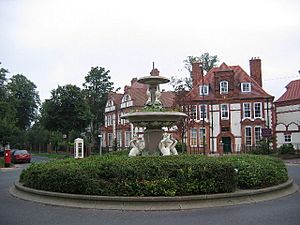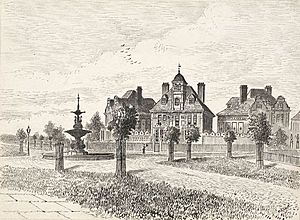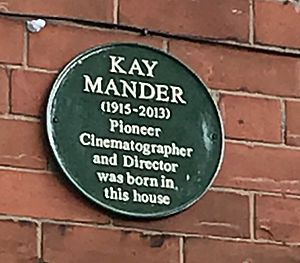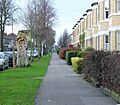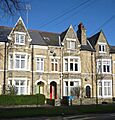The Avenues, Kingston upon Hull facts for kids
The Avenues is a special part of Kingston upon Hull, England. It's known for its large, old Victorian houses. This area has four main streets, called avenues, that are lined with trees. They all branch off from a longer street called Princes Avenue.
The Avenues was first built in the late 1800s for middle-class families. It's still a very popular place to live today. Many creative and smart people, like university teachers, have lived here. Because of its lively and diverse feel, some people jokingly call it Hull's 'Muesli Belt'. Right next to The Avenues, to the south, is another old area with streets named after famous noble homes. This part is sometimes called the Dukeries.
While The Avenues is mostly homes, it also had a special school for girls from 1888 to 1919. This building is now known as the Avenues Centre and is used for education. Another school, Froebel House Preparatory School, is located on Marlborough Avenue. Princes Avenue used to be a very busy shopping street in the 1900s. Today, it's still full of shops, restaurants, and places to eat.
Contents
A Look Back: History of The Avenues
The Avenues was built on what used to be open fields called Newland Tofts. This started in the late 1800s. The name "Newlands" came from land that was made new by draining water in the 1100s. "Tofts" means where houses used to stand.
How the Area Was Planned
The boundaries of this new area were set by different paths and water channels. Newland Tofts Lane (which became Princes Avenue) and Derringham Dike were on the east. Setting Dyke was to the north. Spring Bank and other dikes were to the south. To the west, there was a field boundary that later became Chanterlands Avenue. To the very south, the area was next to the new Hull General Cemetery, which opened in 1847.
Opening and Early Days
The Avenues estate officially opened in 1875. A man named David Parkinson Garbutt was the developer who built it. It was built on the edge of Hull, but it had some nice new places nearby. Pearson Park had opened in 1860, just across Princes Avenue. Also, Hull Botanic Gardens railway station was at the south end of Princes Avenue, making it easy to travel. The area was designed with wide streets for well-off families. Westbourne Avenue, for example, was about 59 feet wide!
Some of the first houses were built between 1877 and 1879 by a famous architect, George Gilbert Scott, Jr.. These houses are now protected as historic buildings. In 1888, a special school called the 'Industrial School for Girls' opened on Park Avenue. It was a place for girls who needed extra guidance. Later, this building was used for other types of education. A small school called Froebel House started on Marlborough Avenue in 1906. It's still open today! Also, St Cuthberts church was built on Marlborough Avenue in the same year.
Transport and Growth
In 1900, electric trams started running on Princes Avenue. This made it much easier for people to travel from The Avenues to the city centre.
The area just south of The Avenues, near the Hull General Cemetery, also started to grow around 1900. Rows of houses were built on streets named after grand homes where dukes lived. These streets included Welbeck Street, Newstead Street, Thoresby Street, Belvoir Street, and Blenheim Street. Because of these names, this part of Hull became known as "the Dukeries".
By 1910, most of The Avenues was fully built up. The areas around it, like Newland Avenue to the north and the Dukeries to the south, also had many new houses. By the 1920s, the land to the west was also developed with Chanterlands Avenue and more houses.
Princes Avenue itself was fully developed by 1910. It became a busy shopping street with many different kinds of stores, like grocery shops, butchers, and sweet shops. There were also important buildings like the Elim Pentecostal church and a Methodist church.
Architectural Styles and Fountains
You can see many different British house styles from the late 1800s and early 1900s in The Avenues. These include the Queen Anne style, mock Tudor, and Arts and Crafts styles.
When the area was first designed, Westbourne, Marlborough, and Victoria Avenue had pretty cast iron fountains in the middle of the roads. Princes Avenue had two more. These fountains were all round with different levels. The fountains on Princes Avenue were removed in 1926 because there was too much traffic. The fountains that are still on Westbourne and Park Avenue are now protected as historic landmarks. A new version of the Victoria Avenue Fountain, which was removed after an accident long ago, was put back in place on July 8, 2023.
Changes in Transport and Environment
The tram system on Princes Avenue was changed to trolleybuses in 1937. Then, in the 1960s, motor buses replaced the trolleybuses. The Hull Botanic Gardens railway station also closed in the 1960s.
Some smaller areas were built up later, like Parkside Close in the 1960s and Muirfield Park in the 1970s. In 1974, The Avenues became a special "Conservation Area" to protect its unique character. In the 1980s, some parts of the area had problems with the ground sinking. This was because of a dry period and many trees drying out the clay soil. As a result, many trees had to be cut down. Local artists carved many of the tree stumps into cool sculptures!
Famous People and Green Plaques
The Avenues and Pearson Park Residents Association has a special project called Green Plaques. These plaques are put up to show where famous people who lived in the area once resided. The first two plaques honored the actor Ian Carmichael and the writer Dorothy L. Sayers.
Other famous people celebrated with plaques in The Avenues include:
- The pioneering female pilot Amy Johnson
- The poet and librarian Philip Larkin
- The film producer Anthony Minghella
- Joseph Boxhall, an officer who survived the Titanic
- The museum curator Thomas Sheppard
- The marine artist Thomas Somerscales
- The historian John Saville
- The artist James Neal
- Film directors Ralph Thomas and Gerald Thomas
- The playwright Alan Plater
- Jean Hartley, who wrote and published Philip Larkin's books
- The groundbreaking female filmmaker Kay Mander
There's even a map that shows where all these famous people lived in the neighborhood!
Images for kids


